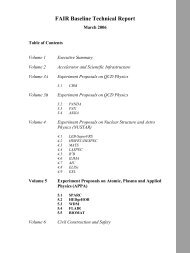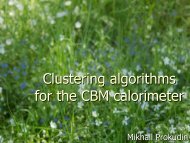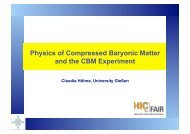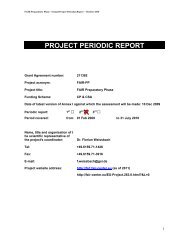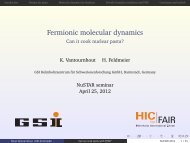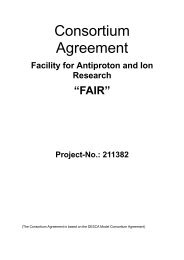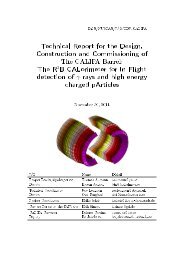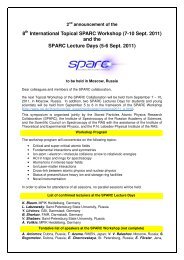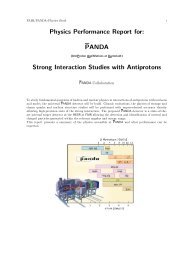NeuLAND - FAIR
NeuLAND - FAIR
NeuLAND - FAIR
You also want an ePaper? Increase the reach of your titles
YUMPU automatically turns print PDFs into web optimized ePapers that Google loves.
events<br />
2000<br />
1000<br />
0<br />
0 20 40 60 80<br />
Nclusters<br />
Figure 4.13.: Number of clusters in <strong>NeuLAND</strong> from 600 AMeV neutrons for multiplicities<br />
of 1 (black), 2 (green), 3 (red), 4 (blue), 5 (yellow) and 6 (magenta).<br />
Calorimetric Properties<br />
Several quantities are regarded here in order to investigate their information content<br />
with respect to the number of incident neutrons. The left part of figure 4.14 shows<br />
the total energy deposited Edep in <strong>NeuLAND</strong> as a function of incident neutron number.<br />
We see a clear and linear increase of the mean value of Edep, however the distributions<br />
overlap for consecutive neutron numbers. When studying the multiplicity, the number<br />
of hits with valid entries in <strong>NeuLAND</strong>, a similar behaviour is observed, see right part<br />
of figure 4.14. As in the case of number of clusters, see figure 4.13, no clear separation<br />
is possible for each of the regarded parameters. However, we can gain a more clear<br />
separation by correlating two of the above mentioned quantities. The best separation<br />
of neutrons is obtained when combining the number of clusters and the total energy<br />
deposited. We observe an anti-correlation, as displayed for neutron multiplicities of 1 to<br />
6 in figure 4.15 for 600 AMeV neutrons.<br />
The cuts indicated in the individual spectra allow for a very satisfactory neutron separation,<br />
as presented in the combined presentation in figure 4.16. The determination of<br />
neutron multiplicities is derived from the conditions in the two-dimensional plane. In<br />
the case displayed here cuts were chosen in a manner, that strongly suppresses a shift<br />
towards higher neutron multiplicities. Additionally, we chose the upper cut for a neutron<br />
multiplicity of four generously, a reasonable assumption for cases where the cross section<br />
for higher neutron multiplicities either drastically drops or vanishes (see the discussion<br />
of GDR studies for 136 Sn with a separation energy for 5 neutrons of S5n=19.6 MeV and<br />
the case of 4 correlated neutrons in section 4.5.4). Depending on the cross sections for<br />
different neutron multiplicities and the investigated physics case, cuts can be optimized<br />
to suppress either too high or too low neutron multiplicities.<br />
54





